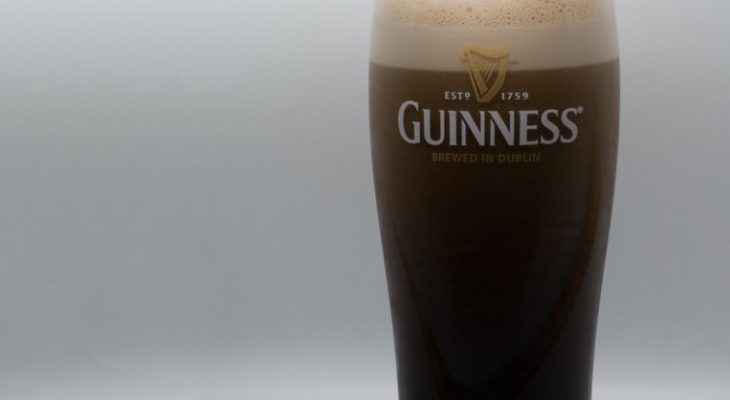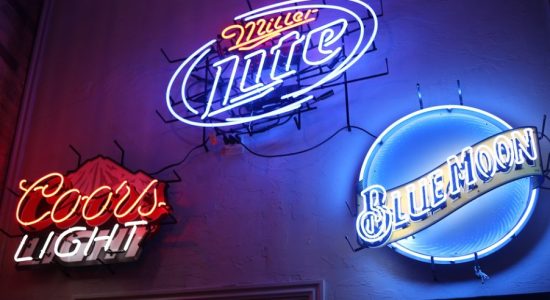Nitro Beer – Everything You Need To Know About Nitro Beer

Nitro beer is gaining popularity as more and more beer makers enter this niche market. It’s a wonder how a tasteless, odorless, and inert gas like nitrogen can change beer lovers’ palates.
Nitro beer is a type of beer that uses more nitrogen than carbon dioxide to pressurize the brew and create fizz and foam. Nitrogen gives the brew a thicker, longer-lasting head, a creamier and smoother mouthfeel, and a less bitter taste than regular carbonated beer.
In this article, I’ll explain everything about nitro beer, including what it is and how it differs from regular beer. I’ll also trace its origins and growth over the years.
What Is Nitro Beer?
Nitro beer contains a mixture of two gases, usually 70-75% nitrogen and 25-30% carbon dioxide. The gases are added on the way to the taps or during the bottling or canning process.
For a long time, carbon dioxide (CO2) was solely used in a process called carbonation. However, nitro beer has been gaining popularity by using nitrogen to create fizz and bubbly foam in beverages and extend their shelf life.
With the level of CO2 still used in nitro beer, the beverage is still carbonated, but the addition of nitrogen changes the aroma, taste, and mouthfeel.
How does a tasteless, odorless, and inert gas change a beer’s taste? That’s a question many beer lovers have asked, so let’s take a detailed look at what nitrogenation does to a beer.
How Nitrogenation Changes a Beer
For consumers, the difference between nitrogenated and regular carbonated beer begins the moment the brew is poured.
A freshly poured glass of nitro beer is a visual treat. As the beer hits the bottom of the glass, bubbles surge upwards and slowly settle into a thick, long-lasting creamy head.
The rising bubbles push those on the sides downwards, creating that mesmerizing cascading waterfall effect seen in many nitro-beer advertisements.
A pint glass, with a narrow base and a wide rim, aids this unusual downward flow of bubbles, which happens only on the sides of the glass. In the less-visible middle, the bubbles rise.
The bubbles are more than just a treat for the eyes. They make almost all the difference in a nitrogenated beer. At play are some of the properties of nitrogen:
Nitrogen Is Insoluble at Ambient Temperatures
Unlike CO2, nitrogen doesn’t dissolve easily in liquids. It requires very high pressure and cold temperature. This property of nitrogen explains the profuse bubbles in freshly poured nitro beer.
When you crack open a can of nitro beer, depressurization occurs, and the dissolved nitrogen escapes as a gas via bubbles.
In pubs, this process is spurred by a perforated restrictor plate on the nitro taps. When the beer jets out through the tiny perforations, a more intense effervescence is created in the glass,
In bottles and cans, the same result is often achieved with a nitrogen-filled widget. Where there’s no widget, it’s enough to hard-pour the beer into the glass to stir up the bubble surge.
According to former Guinness Master Brewer Fergal Murray, a pint of Guinness stout can raise up to 300 million bubbles! That compares with less than 500,000 for most regular carbonated beers.
Nitrogen Molecules Are Smaller Than CO2
Because nitrogen molecules are smaller than CO2 molecules, nitrogen bubbles are smaller and more stable, meaning they won’t burst as quickly as the bigger CO2 bubbles.
CO2 bubbles will continue to absorb CO2 from the air and become even bigger and more unstable. For nitrogen bubbles, this expansion is limited, partly because air is 78% nitrogen.
The smaller, longer-lasting, and more profuse nitrogen bubbles give nitro beer its smooth, velvety mouthfeel and thick foamy head.
Nitrogen Is an Inert Gas
Beer is naturally carbonated mildly during fermentation. When yeast converts the sugar in the wort to alcohol, CO2 is also produced.
As I explained in my article, Mash vs. Wort: The Differences Explained, wort is the liquid you get from mashing (mixing grain and water). Fermentation begins when yeast is added to the wort.
The CO2 reacts with water to form carbonic acid, giving the beer an acidic or bitter taste. That taste is accentuated by adding pressurized CO2 during the carbonation process.
Nitrogen, on the other hand, is almost inert and does not react with water. No new compounds are formed when nitrogen is added to a beer.
Nitrogen Is Tasteless
Additionally, nitrogen is tasteless, as is CO2. Being inert and tasteless, nitrogen does nothing to change the taste of a beer or any other drink. Then, why does nitro beer taste different?
In nitro beer, nitrogen replaces about 70% of the CO2 typically found in a fully carbonated beer. The lower CO2 content in nitro beer limits the taste-changing effects of CO2.
The infusion of nitrogen and the significant decrease in CO2 content allows the beer to retain much of its natural taste, sweetness, and flavor and reduces the prickly acidic taste of carbonic acid.
What Types of Beer Are on Nitro?
Generally, CO2 enhances hop aromas and diminishes malty sweetness and flavors. That’s why most malt-heavy stouts and porters are traditionally only mildly carbonated.
To learn more about malt and hops in beer, you can read my article, 8 Essential Ingredients You Need To Brew Beer.
Since the infusion of nitrogen reduces the effects of CO2, you’ll find more malt-heavy porters and stouts on nitro than hoppy beers such as IPAs (India Pale Ales), pilsners, and bitters.
However, with the popularity of nitro beer and the arrival of simple-to-operate nitrogen dosing machines, many craft breweries and brewpubs are experimenting with nitro in all types of beer.
So it’s not unusual nowadays to see nitro versions of IPAs and pilsners in cans and bottles. Even Guinness introduced a nitro IPA in 2015 that has become pretty popular.
Like mead and regular beers, nitro beers often carry flavors of coffee, fruits, spices, and herbs. Some of these flavored nitros have captured beer lovers’ palates.
For an idea of the flavors that can be added to beer, see my article, 3 Things You Can Add to Homebrew Beer for Flavor.
Is Nitro Beer Safe To Drink?
Nitro beer is generally as safe as, or safer than, standard beer. Nitrogen comprises 78% of the air we breathe, and adding it to a drink doesn’t make it unsafe.
Also, since nitrogen doesn’t dissolve easily in the beer, you won’t consume much of the gas when you down your favorite pint of nitro.
In fact, nitro beer may even be healthier because it contains less CO2 than regular beer. CO2 is acidic and can harm your teeth and gut.
As for alcohol content, there’s not much difference between nitro and regular beer. Some nitro beers have an ABV (alcohol by volume) of 7% compared to 4%-5% for the average beer.
However, some regular beers also have a similarly high ABV. Guinness Draught, the leading nitro beer, has an ABV of only 4.2%.
The Origins of Nitro Beer
The story of nitrogenated beer goes back several centuries – long before Guinness launched the world’s first nitro beer in the late 1950s.
Traditional English Ales Were Nitrogenated
In the England of yore, stouts, porters, and other traditional ales were brewed in wooden casks. These casks could barely withstand the pressure of the CO2 that formed during fermentation.
For this reason, the ale was only mildly carbonated, and the breweries sent it in wooden casks to the pubs. The casks often contained live yeasts and beer that wasn’t fully fermented.
After conditioning the beer in cellars at a temperature of 55 °F (12.8 °C), the publicans used hand pumps (also known as beer engines) to pressurize the ale with air before bottling it.
Since 78% of air is nitrogen, this process was mostly nitrogenation. The process wasn’t ideal because air contains 21% oxygen, and the ale would get oxidized if not finished in a day or two.
The Problem: Stout on Draft Was Not Readily Available
In pubs, the bottled ale was kept on shelves at room temperature, which was how Guinness stout was mostly served to customers for 200 years since the Irish brewery set up shop in 1759.
That became a problem for Guinness when draft beer gained popularity. Pub-goers were increasingly asking for cold beer that could be served on tap immediately.
Some pubs served Guinness on draft, but the process was cumbersome. It involved mixing Guinness stout drawn separately from high-pressure and low-pressure casks.
The pressure in the casks and the mixture in the glass were inconsistent across different pubs, making for an unsatisfactory beer-drinking experience for consumers.
Guinness’ Innovative Solution: Nitro on Tap
Guinness teams worked on the issue since 1932, but a solution proved elusive until 1959. The man who cracked the problem was Michael Ash, a mathematician-turned-brewer at Guinness.
Now considered the father of nitro, Ash’s solution was nitrogen. He designed a two-chamber keg, one holding the ale and the other mostly nitrogen along with CO2.
Luckily for Ash and Guinness, metal kegs had arrived on the beer scene a few years earlier. These kegs could hold nitrogen and CO2 at much higher pressures than wooden casks.
The ale was mixed with the gases as it made its way to the tap. Anyone could now serve cold and consistent Guinness Stout by turning on a tap in a pub.
Another Guinness Innovation: Nitro in a Can
Until the 1980s, that was the only place to enjoy a Guinness: the pub. The Guinness team spent the intervening two decades working on a to-go version of Guinness Draught.
Because nitrogen won’t stay long in the beer at room pressure, it was challenging to package the bubbly Guinness experience in a bottle or can.
Another Guinness innovation made that possible: a nitrogen-filled widget inside the bottles and cans. The widget had a few iterations, the current version being a small plastic ball with a hole.
How the Widget Works
The widget was a simple solution to a very challenging problem. During the canning or bottling process, the brew is infused with pressurized nitrogen.
The nitrogen, along with a little beer, enters the widget, and the can or bottle is pressurized and sealed. This process also enhances the shelf life of the beer.
When you open a can of Guinness Draught, it will immediately depressurize. However, the pressure inside the widget will still be higher than the pressure of the surrounding beer.
The pressurized nitrogen will hiss out of the widget, forming profuse bubbles as it mixes with the beer. You’ll see the cascading effect as the thick foamy head forms.
Now you know what makes that clanking sound when you shake an empty Guinness can. It’s the humble widget that enables you to enjoy a cold Guinness in the comfort of your living room.
How Nitro Beer Became a Trend
Although Guinness Draught, the world’s first nitro beer, has been around since 1959, the nitro trend began to take off only in the mid-1980s.
Until then, Guinness Draught was the only nitro drink on the beer market. Since nitro could only be served on tap, it was a tough act for small breweries to follow.
Even big breweries were reluctant to add a new draft beer to compete with their signature brand. All that changed with the arrival of Guinness Draught in bottles and cans.
Other prominent players, including Boddingtons and John Smith’s in England, launched nitro versions of their bitters in cans that featured widgets.
Growth of Nitro Beer in America
In America, the trend was late to take off. Although a few Nitro beers were launched between 1985 and 2010, it wasn’t until 2011 that American beer lovers began to take notice.
That was when Colorado’s Left Hand Brewing Company launched the nitro version of its popular Milk Stout to much acclaim at the Great American Beer Festival.
Left Hand used pioneering technology to launch its nitro beer in a bottle without a widget. In 2017, the company launched its Milk Stout Nitro in a widget can.
Even today, the company produces both regular and nitro versions of its Milk Stout and having them side by side is a great way to appreciate the differences between the two types of beer.
If you’re wondering what a milk stout is and how it differs from regular stouts, watch this video to have all your questions answered:
How Technology Spurred the Nitro Trend
Until recently, barriers to entry into the nitro market were high. Consistently achieving the precise balance of nitrogen and CO2 was challenging for many breweries.
Since then, equipment manufacturers have developed a range of advanced, precise, and easy-to-operate nitrogen dosing systems for big and small breweries and even home brewers.
These machines remove oxygen from empty cans or bottles and add liquid nitrogen and CO2 in precise, pre-specified proportions before sealing.
The liquid nitrogen vaporizes as it warms, and the expanding gas pressurizes the can. After opening a can, you only need to hard-pour the beer into a glass to activate the nitrogen bubbles.
These new machines enable nitro beer to be produced even in small quantities cost-effectively. They opened the nitro floodgates to craft breweries and brewpubs.
Almost every mass brewery and craft beer outfit now has at least one nitro product. There’s no official count of nitro brands, but the beer rating site RateBeer lists over 2,300 nitro beers.
That shows the exponential growth of nitro beer, although it’s still a tiny fraction of the 715,000 beers the site examines every year.
Final Thoughts
Is nitro beer a trend that will keep growing or a fad that will fade away? The popularity of the 63-year-old Guinness Draught is proof nitro is here to stay.
With nitrogen dosing becoming affordable even for small quantities, craft outfits will continue experimenting in the nitro realm, offering variety for beer lovers.
Should you go nitro? Well, it all boils down to personal preference. The only way to determine whether nitro is for you is to down a couple of cold ones and taste the difference. Cheers!






